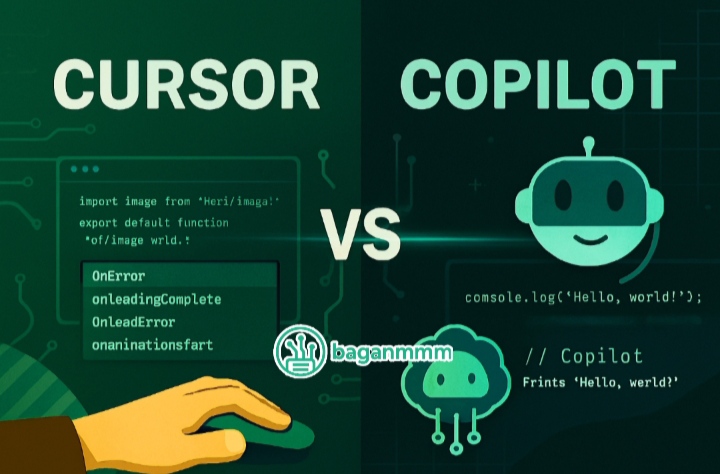In 2025, artificial intelligence has become a cornerstone of modern software development. What once required hours of manual coding, debugging, and documentation can now be done in minutes — thanks to AI-powered coding assistants. These tools don’t just autocomplete lines of code; they understand context, generate entire modules, refactor logic, and even simulate test cases.

AI coding assistants are transforming how developers work. They reduce cognitive load, accelerate delivery, and democratize programming for non-coders. But with so many tools on the market, two names dominate the conversation: GitHub Copilot and Cursor.
Both are powered by cutting-edge language models like GPT-4o and Claude 3.5, but they take radically different approaches to how AI should assist developers. Let’s break down the competition.
What Is Cursor?
An AI-Native IDE That’s Redefining How Developers Code
Cursor is not just another plugin or autocomplete tool — it’s a full-fledged AI-first Integrated Development Environment (IDE) built on top of Visual Studio Code. Designed from the ground up to integrate artificial intelligence into every layer of the coding experience, Cursor transforms traditional development into a dynamic, conversational workflow.
By 2025, Cursor has become one of the fastest-growing AI coding platforms, with over 1 million active users generating billions of lines of code monthly. It’s trusted by engineering teams at OpenAI, Samsung, and Fortune 1000 companies.
Core Features That Set Cursor Apart
| Feature | Description |
|---|---|
| Agent Mode | Allows AI to autonomously execute multi-step tasks like creating files, modifying configs, and running commands — with user confirmation for safety. |
| Composer | Supports multi-file editing and refactoring. Developers can select multiple files, describe a change, and preview diffs before applying updates. |
| AI Chat Assistant | Sidebar chat that understands your entire codebase. Ask questions like “What does this function do?” or “Refactor this class” and get context-aware responses. |
| Natural Language Editing | Use plain English to describe code changes. Cursor interprets instructions and rewrites or generates code accordingly. |
| Smart Autocomplete | Predicts multi-line completions based on your coding style and recent edits. Goes beyond syntax to infer developer intent. |
| Terminal Automation | Converts natural language into shell commands. For example, “Open README.md in Vim” becomes an executable terminal command. |
| Image-Based Prompts | Upload design mockups or screenshots, and Cursor generates matching frontend code — ideal for UI/UX developers. |
| Multi-Model Support | Lets users choose from 25+ large language models including GPT-4o, Claude 3.5 Sonnet, Gemini 2.5, and DeepSeek — offering flexibility and precision. |
Security Considerations
Cursor’s deep integration with AI comes with trade-offs. A recent report highlighted that Workspace Trust is disabled by default, which can allow malicious repositories to auto-execute tasks when opened. The Cursor team has acknowledged this and recommends enabling Workspace Trust manually when working with unknown codebases.
Why Developers Love Cursor
– Speed: Tasks that used to take 10–15 minutes (e.g., building a layout or refactoring logic) now take seconds.
– Context Awareness: Cursor understands your entire project — not just the file you’re in.
– Creative Flow: Cursor supports “vibe coding,” where developers stay in the zone by interacting naturally with their IDE.
– Customization: You’re not locked into one model — switch between Claude, GPT, Gemini, and more depending on your task.
What Is GitHub Copilot?
Your AI-Powered Coding Partner, Embedded in Every Workflow
GitHub Copilot is an intelligent coding assistant developed by GitHub and OpenAI. Originally launched in 2021, it has evolved into a full-featured AI pair programmer by 2025 — capable of generating code, refactoring logic, writing tests, reviewing pull requests, and even responding to voice commands.
It’s not just a plugin anymore. With the release of GitHub Copilot X, it now integrates deeply into IDEs, terminals, GitHub issues, and team workflows — making it a central part of how millions of developers build software.
Core Capabilities of GitHub Copilot (2025)
| Feature | Description |
|---|---|
| Multiline Code Suggestions | Generates entire functions, class templates, and logic blocks based on context — not just single-line completions. |
| Copilot Chat | Conversational interface embedded in IDEs and GitHub Mobile. Ask questions, request code edits, or get explanations in natural language. |
| Copilot Coding Agent | Assign GitHub issues to Copilot and it autonomously makes code changes, creates pull requests, and summarizes edits. |
| Copilot CLI | Chat-like interface in the terminal. Ask for command suggestions, shell script generation, or explanations of CLI tools. |
| Copilot Edits | Make changes across multiple files using a single prompt. Available in VS Code, JetBrains IDEs, and Visual Studio. |
| Pull Request Summaries | Automatically generates summaries of code changes, impacted files, and key review points for faster collaboration. |
| Secure Code Generation | Flags insecure patterns and suggests safer alternatives based on OWASP standards and best practices. |
| Voice-Powered Coding (Beta) | Enables developers to write and edit code using natural speech — improving accessibility and hands-free workflows. |
| Copilot Extensions | Integrates external tools into Copilot Chat via GitHub Marketplace. Developers can build and share their own extensions. |
Language & Framework Support
Copilot supports over 30 programming languages, including:
– Python, JavaScript, TypeScript, Go, Rust, Java, C#, Ruby
– Frameworks like React 19, Next.js, Flutter 4, .NET 8, Django, Laravel
It understands idiomatic patterns, best practices, and common libraries — making it useful across frontend, backend, mobile, and cloud development.
Real-World Impact
– Adopted by 3M+ developers globally
– Integrated into 90% of Fortune 500 software teams
– Used in 150M+ code commits in 2024 alone
– Delivers an average 30% boost in developer productivity
GitHub’s internal studies show that developers using Copilot complete tasks faster, write cleaner code, and spend less time on boilerplate.
Where Copilot Works
– IDEs: VS Code, JetBrains, Visual Studio, Xcode, Eclipse, Neovim
– GitHub Web & Mobile: Chat, pull requests, issues
– Windows Terminal & CLI: Natural language command generation
– GitHub Marketplace: Extensions and integrations
The Competition: Cursor vs Copilot
While both tools aim to boost developer productivity, their philosophies diverge:
| Feature | Cursor | GitHub Copilot |
|---|---|---|
| Core Concept | AI-native IDE built from the ground up for intelligent coding workflows | AI plugin designed to enhance existing IDEs like VS Code and JetBrains |
| Model Flexibility | Supports 25+ LLMs including GPT-4o, Claude 3.5, Gemini 2.5, DeepSeek | Primarily uses OpenAI models (GPT-4o, GPT-3.5); Gemini integration in progress |
| Autonomy | Agent Mode allows AI to execute multi-step tasks, create files, and run commands | Chat-based suggestions and completions; task delegation features emerging |
| Context Handling | Understands entire project context across multiple files and folders | File-level context awareness with inline suggestions |
| User Experience | Requires switching to Cursor IDE (VS Code fork) | Seamless integration into existing IDEs; minimal setup required |
| Debugging | Auto-debugging with real-time error detection and fix suggestions | Syntax and logic suggestions; relies on user prompts for deeper fixes |
| Learning Curve | Steeper curve with advanced features and full IDE control | Beginner-friendly with intuitive autocomplete and chat interface |
Cursor is ideal for developers who want to reimagine their workflow with AI at the center. Copilot is perfect for those who want to enhance their existing setup without disruption.
Future Competition: What’s Next?
The battle between Cursor and Copilot is far from over. Here’s what’s on the horizon:
– Model Wars: Cursor’s multi-model flexibility gives it an edge in customization, while Copilot is integrating Gemini 2.5 Pro and expanding its agent capabilities.
– Enterprise Adoption: Copilot is deeply embedded in Microsoft’s ecosystem, making it attractive for large teams. Cursor is gaining traction among startups and advanced developers.
– AI Autonomy: Cursor’s Agent Mode may evolve into full autonomous coding agents, while Copilot is refining its “delegation panel” for task-based AI workflows.
– Community & Ecosystem: Copilot benefits from GitHub’s massive user base and documentation. Cursor is building a niche but loyal developer community.
Final Thought
In the competition between Cursor and Copilot, there’s no universal winner — only the right fit for your coding style. Cursor offers depth, autonomy, and control. Copilot offers speed, simplicity, and seamless integration. As AI coding tools evolve, developers will increasingly act as orchestrators — guiding intelligent systems to build, test, and deploy software faster than ever before.
Alice is the visionary behind Baganmmm Tech, a platform he founded with a passion for demystifying the complex world of technology. As the Lead Technologist, he's often found in his home lab – a cozy, wire-filled sanctuary where ideas are born and code is meticulously crafted. His infectious enthusiasm and knack for explaining intricate concepts make him the go-to expert for everything from web development to emerging tech trends.
